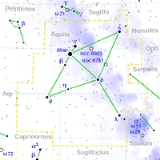
Iota Aquilae
Encyclopedia
Iota Aquilae is a binary star
in the constellation
Aquila
. It has the traditional name Al Thalimain, which it shares with λ Aquilae. The name is derived from the Arabic
term الثالمين ath-thalīmain meaning "The Two Ostriches".
In Chinese
, , meaning Right Flag
, refers to an asterism consisting of ι Aquilae, μ Aquilae, σ Aquilae
, δ Aquilae
, ν Aquilae
, 42 Aquilae
, HD 184701, κ Aquilae
and 56 Aquilae
. Consequently, ι Aquilae itself is known as
Iota Aquilae is a blue-white B-type
star with an apparent magnitude
of +4.36. Although it is listed in star catalogues as a giant star
, calculations of its dimension show that in reality it is a dwarf
. It is approximately 307 light years
from Earth
and has an optical companion with an apparent magnitude of +13,0 mag in a distance of 47,0".
Binary star
A binary star is a star system consisting of two stars orbiting around their common center of mass. The brighter star is called the primary and the other is its companion star, comes, or secondary...
in the constellation
Constellation
In modern astronomy, a constellation is an internationally defined area of the celestial sphere. These areas are grouped around asterisms, patterns formed by prominent stars within apparent proximity to one another on Earth's night sky....
Aquila
Aquila (constellation)
Aquila is a stellar constellation. Its name is Latin for 'eagle' and it is commonly represented as such. In mythology, Aquila was owned by the Roman god Jupiter and performed many tasks for him....
. It has the traditional name Al Thalimain, which it shares with λ Aquilae. The name is derived from the Arabic
Arabic language
Arabic is a name applied to the descendants of the Classical Arabic language of the 6th century AD, used most prominently in the Quran, the Islamic Holy Book...
term الثالمين ath-thalīmain meaning "The Two Ostriches".
In Chinese
Chinese language
The Chinese language is a language or language family consisting of varieties which are mutually intelligible to varying degrees. Originally the indigenous languages spoken by the Han Chinese in China, it forms one of the branches of Sino-Tibetan family of languages...
, , meaning Right Flag
Ox (Chinese constellation)
The Ox mansion is one of the Twenty-eight mansions of the Chinese constellations. It is one of the northern mansions of the Black Tortoise.-Asterisms:...
, refers to an asterism consisting of ι Aquilae, μ Aquilae, σ Aquilae
Sigma Aquilae
Sigma Aquilae is a binary star in the constellation Aquila. It is approximately 680 light years from Earth.Sigma Aquilae is an eclipsing spectroscopic binary. Both components are detached blue-white B-type main sequence dwarfs which do not fill their Roche lobes. The mean apparent magnitude of...
, δ Aquilae
Delta Aquilae
Delta Aquilae is a triple star system in the constellation Aquila. It is approximately 50.1 light years from Earth.Sometimes, this star is called by the name Denebokab, meaning the tail of eagle in Arabic...
, ν Aquilae
Nu Aquilae
Nu Aquilae is a star in the constellation Aquila.Nu Aquilae is a yellow-white F-type supergiant with an apparent magnitude of +4.64. It is at least 3000 light years from Earth and lies close to the celestial equator.-References:...
, 42 Aquilae
42 Aquilae
42 Aquilae is a star in the constellation Aquila. Its apparent magnitude is 5.45....
, HD 184701, κ Aquilae
Kappa Aquilae
Kappa Aquilae is a star in the constellation Aquila.Kappa Aquilae is a blue-white B-type giant with an apparent magnitude of +4.93. It is approximately 1460 light years from Earth.-References:* * *...
and 56 Aquilae
56 Aquilae
56 Aquilae is a star in the constellation Aquila. Its apparent magnitude is 5.76, meaning it would be barely visible to the naked eye, under ideal conditions.It was discovered by nineteenth Century Astronomer John Herschel....
. Consequently, ι Aquilae itself is known as
Iota Aquilae is a blue-white B-type
Stellar classification
In astronomy, stellar classification is a classification of stars based on their spectral characteristics. The spectral class of a star is a designated class of a star describing the ionization of its chromosphere, what atomic excitations are most prominent in the light, giving an objective measure...
star with an apparent magnitude
Apparent magnitude
The apparent magnitude of a celestial body is a measure of its brightness as seen by an observer on Earth, adjusted to the value it would have in the absence of the atmosphere...
of +4.36. Although it is listed in star catalogues as a giant star
Giant star
A giant star is a star with substantially larger radius and luminosity than a main sequence star of the same surface temperature. Typically, giant stars have radii between 10 and 100 solar radii and luminosities between 10 and 1,000 times that of the Sun. Stars still more luminous than giants are...
, calculations of its dimension show that in reality it is a dwarf
Dwarf star
The term dwarf star refers to a variety of distinct classes of stars.* Dwarf star alone generally refers to any main sequence star, a star of luminosity class V.** Red dwarfs are low-mass main sequence stars....
. It is approximately 307 light years
Light Years
Light Years is the seventh studio album by Australian recording artist Kylie Minogue. It was released on 25 September 2000 by Parlophone and Mushroom Records. The album's style was indicative of her return to "mainstream pop dance tunes"....
from Earth
Earth
Earth is the third planet from the Sun, and the densest and fifth-largest of the eight planets in the Solar System. It is also the largest of the Solar System's four terrestrial planets...
and has an optical companion with an apparent magnitude of +13,0 mag in a distance of 47,0".

